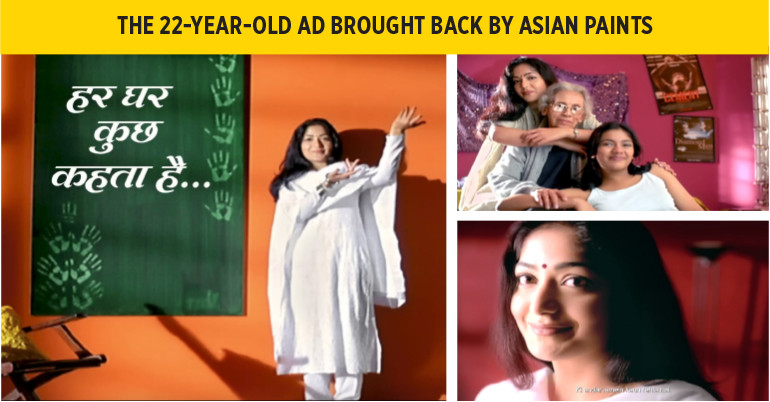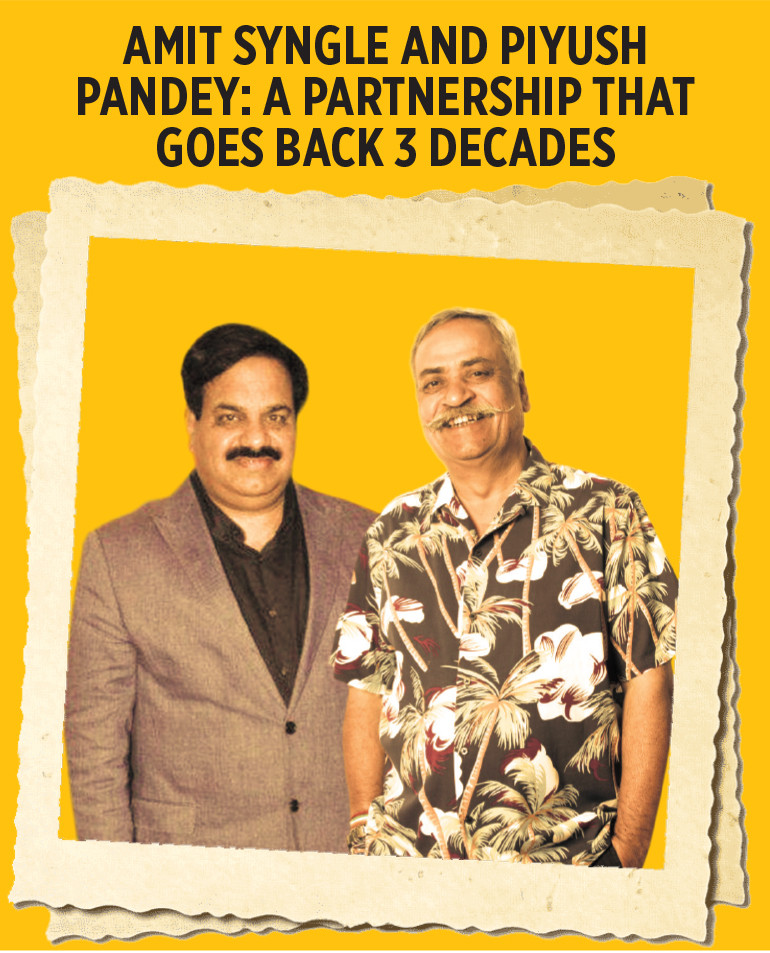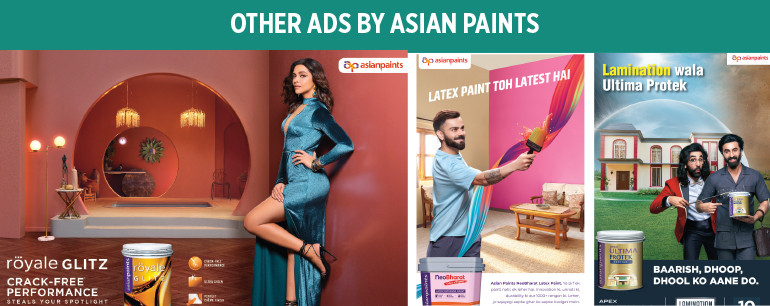Q] Asian Paints has made several memorable campaigns in the past few decades, why did you handpick ‘Har Ghar Kuch Kehta Hai’ ad for a return after 22 long years?
Amit: Some things are iconic, ageless, and timeless. In 2001-2002, we were moving away from associating paints with just festive celebrations to looking at homes as a part of our life journey, filled with high voltage emotions. We wanted to show that Asian Paints and homes are connected. That’s when Piyush Pandey, the creative genius came up with this iconic idea of ‘Har Ghar..’ Back then it really turned the tables for us and projected us in the area of homes very strongly. It continues to have relevance in today’s world. Thus, we thought why not bring it back?
Q] Mr. Pandey, in the past few years we have seen so many brands revamping themselves to keep up with the changing times. To your credit, you created a tagline which Asian Paints is using even after two decades. How did you come up with it? And Mr Syngle, while you loved the idea, did you feel as a Marketing Head back then that it would be an evergreen one?
Piyush: Madhukar Sabnavis, then a planner and I were working on the idea that the home is an extension of your personality. There was this one magical moment when I started writing the verses with no specific strategy in place. I called Amit and his boss at that time, KBS Anand and said, ‘What are you doing right now? Drop everything and meet me in my office!’ They came and I presented the lines which you later saw in the ad, and all three of us hugged each other with moist eyes because we were sitting on something that came straight from the heart. And now, 22 years later, we believe it is young and fresh enough to be re-run as it is. The only thing we changed is our logo, we have not touched anything else in the ad.
Amit: I remember when Piyush recited it, we could feel goosebumps and the magic. It hit us that it could cut across segmentation and profiles, because it was not contrived or imposed. We immediately told him that we love it. ‘Har Ghar..’ was the beginning and end of the copy he had written and that incidentally also went on to become the corporate positioning and strategy for us in terms of going forward. At that point of time, we discussed, are we really ahead of the time in terms of appropriating home decor in this way? Because if you see the ad, it was more purist, and not just about showing paint or walls, it was showing the home in its pure form. Its beauty was in the fact that it tapped the emotions of homemaking, solely on intuitive skills.
Piyush: Yes, the tagline actually opened up possibilities because Asian Paints got into interiors, tiling, home décor etc after that. There is a line which I really love— Is Farsh pe nange pair kiske bachche chalte hai? Asian Paints was not making floors at that time, basically the ad spoke about so much more than just paints.

Q] You moved beyond paints to enter the home décor space a few years ago, how much does that contribute to the company’s overall revenue today?
Amit: We are still fairly young in that regard; it contributes about four percent to our decorative turnover and we aim to take it to about 8 to 10 percent of our overall business. It’s a category much like the fashion industry where you have to be on top of what’s trending. It’s also about becoming an integrated home decor player. You can’t talk just about categories, you have to consider the entire home. In India, whether it is furnishings or rugs, we only have specialised players. We are attempting something very different. We are talking about everything within the home space and at the same time embracing the phygital model. Now that is fairly ambitious. The biggest advantage of this home decor journey is that it complements our core business, the diversification is not into an unrelated space. Now we are talking about opening one of the biggest stores in India, something which we shall unveil in Q3.
Q] One thing that hasn’t changed since 2002 is your market leader position in overall paints segment. How have you managed to retain that in a category which has seen many new big players like Birla Opus, JSW Paints etc?
Amit: It’s all courtesy the consumer. One must own the emotions around the consumer and become their preferred brand. Over the last two to three decades, we have kept that emotion alive which is what differentiates our brand. The core value of Asian Paints has always remained the same – bringing joy and happiness to people’s lives. And we’ve been strongly working on that paradigm. All the other things—innovation, getting into home décor category or distribution strength— are simply propelling that thought.

Q] Is inching towards global dominance the next big goal for an Indian multinational paints company like Asian Paints Ltd.?
Amit: Four years ago, we were closer to about INR 19000 crores, and now we are close to INR 36000 crores, so we have nearly doubled the turnover. We are making ourselves more and more relevant, and today we are part of the home decor life cycle of the customer. From renting out a place to the first ownership, the first renovation to the second home, and later your kids’ home – we aim to complete the full life cycle and stay relevant throughout it. That is something which we have been appropriating strongly. Therefore, you see this diversification in home decor. We are taking this forward by looking at some of the spaces, even outside India. We are considering opening a store in Dubai. Today we are amongst the top five players in paints category globally. What really matters is that we are progressing along with the customer.
Q] Another thing that hasn’t changed is Asian Paints’ partnership with Ogilvy and Piyush, which goes back three decades or more. Is it because of brand- Piyush Pandey, or team Ogilvy?
Piyush: I’d like to answer that, this relationship goes back to 1984. I joined Ogilvy in 1982, and at that time I was a nobody. Amit joined Asian Paints in 1990s, and he was a nobody. I came in to work on the creative side of it only around the late 80s, or early 90s. So, the relationship belongs to companies. Individuals can only strengthen it from time to time. Many people on both sides stood for the same values. They took it forward, and now we’re taking it even further.
Amit: Personalities only add spark to the relationship like Piyush and I did. It is physically impossible for one person to do everything. So, it’s the full body of work which really matters.

Q] Now frequency of pitches has increased, agency-brand relationships have become flings instead of marriages, like yours. Would you say five or ten years from now, such decades-long relationships are going to become only a nostalgia invoking phenomenon?
Piyush: You can also turn it around completely. Five years from now our young guns will be pulling their hair out and saying, ‘Kya Kya bakwas ki thi? Chalo ab long lasting relationships banate hai’.
Amit: I always feel that brands who are not clear about their strategies think of getting strategies from a new pitch. Brands need to be clear regarding what they are pursuing because the strategies and ideas stem from the co-existence of both. You cannot hunt for new ideas in new pitches. One has to be very clear on why you are looking for a new pitch or an agency. I strongly feel that today, if your relationship is strong, your work will reflect that. But you can’t hunt for newer strategies by just calling for a new pitch.
Q] Of late, we’ve seen the return of nostalgia in a big way, be it brands like Rol-a-Cola or Campa Cola, Boomer, etc., or ads like Cadbury’s Kuch Khaas Hai—audience has received some of them well, others not so much. How will an untouched ad from 22 years ago, appeal to GenZ?
Amit: I remember calling Piyush to tell him that some people in my team are asking what is its relevance to the younger generation? He said, ‘This is an emotion,’ something universal. It’s not something that can change from generation to generation. So, whether it is Gen Z, millennials or any other generation, the emotion remains the same. You are showing different generations in this ad, from an old grandmother to a child. The concept is so beautiful.
Piyush: We’re telling you that ‘Har Ghar..’ softly says who lives in it and that person residing in it could be Gen Z, could be you, or somebody older like me, could be every man or woman.

Q] We’ve seen Asian Paints with many brand ambassadors across different products, but never an overall one for the mother brand, why? Also, who was the most effective/successful brand ambassador for you?
Piyush: On a lighter note, I would pick Sunil Babu. The idea is not to be dependent on celebrities, but to use them for a purpose.
Amit: Brand ambassadors don’t make the brand, some of them just contribute by playing a certain specific role. When we got Deepika Padukone, we wanted to push Royale from a space of royalty to a place of sophistication through her demeanour and personality. We call campaigns successful more from a point of view of what we did to make it so. For example, the ‘Mera Wala Blue’ was a simple ad that did not have any brand personality and yet is remembered even today. Our hero brand ambassador is the common man. Everybody remembers Sunil Babu and the essence of that ad.























